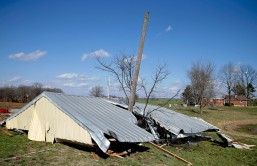Scientists will soon release robots in the Bay of Bengal in order to comprehend how ocean conditions can affect rainfall patterns.
Ministry of Earth Sciences Secretary M Rajeevan disclosed that the Indian Research Vessel Sindhu Sadhana will carry scientists from Chennai on June 24.
"Once out in the ocean, they will release seven underwater gliders to measure ocean properties such as temperature, salinity and current," he said.
Lead researcher Prof Adrian Matthews, from UEA's School of Environmental Sciences, said "The Indian monsoon is notoriously hard to predict. It is a very complicated weather system and the processes are not understood or recorded in science.
"We will be combining oceanic and atmospheric measurements to monitor weather systems as they are generated. Nobody has ever made observations on this scale during the monsoon season itself, so this is a truly ground-breaking project".
The monsoon typically hits India between June and September and is responsible for a major part of its annual rainfall. Millions wait eagerly for its arrival, with delays leading to drought and ruined crops.
However, the monsoons have not been totally understood, as they are affected by the interaction between global atmospheric as well as oceanic movements. Weather phenomena such as El Nino can affect them. Climate change and even air pollution can make monsoons arbitrary in their behavior and occurrence.
"It's such a complex system," said oceanographer Ben Webber at the University of East Anglia's School of Environmental Sciences, the UK university leading the $11 million project. Still, "the processes that occur in the Bay of Bengal are not well understood."
It is not known how water currents work. The "colder and fresher" water tend to stream into the northern region, with warmer, saltier water moving further south from the Arabian Sea. The cold water stays on the surface, even as the warm saline water is active below.
However, with the two streams intermingling, the warm water shifts to the surface, releasing heat and moisture that powers atmospheric storms.
Scientists are aware that minor changes in the surface temperatures might make a large impact, but they have never completely examined these changes in the monsoons. Working on a ship in the severe weather tends to call for navigation of strong winds and high waves.
"We don't know what we're going to find. There's been so little observation," Webber said. "We may confirm what we think theoretically. But we really don't know. It's quite exciting."
This month, in an Indian research ship, British scientists will release seven underwater robots across 400 kilometers, which will navigate to 1,000 meters.
Experts from the University of Reading and the government are expected to take atmospheric measurements. Comparing both sets of data will help scientists to become aware of how ocean conditions affect monsoon patterns.
The Bay of Bengal Boundary Layer Experiment (BoBBLE) is led by two UK varsities, University of East Anglia (UEA) and the University of Reading in collaboration with the National Oceanography Centre (NOC) in Southampton.
Indian collaborators include the Centre for Atmospheric and Oceanic Sciences (CAOS), the Indian National Centre for Climate Information Services (INCOIS), the National Centre for Medium Range Weather Forecasting (NCMRWF) and the National Institute of Ocean Technology.
This year's monsoon arrived a week late on June 8. It has been slow in its travel to the north and relieving a drought.
After the government started a program in 2012 to improve its monsoon predictions, it plans to spend at least $43 million through 2017 improving its technology and computing capability for more accurate calculations and models of seasonal weather forecasts, according to the Ministry of Earth Sciences.
"We need to better understand how the monsoon works," said meteorologist D.P. Yadav, who works on monsoon forecasts for the government. "Most of our states' economies depend on it. It is the most important weather event for India."








